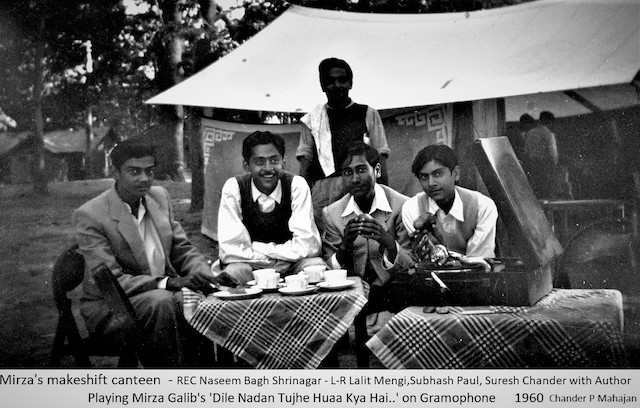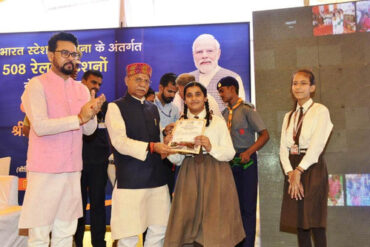 1962 was a terrible year for India. The once-friendly China had turned foe and invaded its NE frontiers. As they faced off at the frontiers, Pakistan leaned towards China, making an already nervous India, wary. Horrifying sirens, blackouts and the terrifying sounds of the bomber jets haunted us on the campus day in and day out. Dictates to hide in the trenches could not be evaded.
1962 was a terrible year for India. The once-friendly China had turned foe and invaded its NE frontiers. As they faced off at the frontiers, Pakistan leaned towards China, making an already nervous India, wary. Horrifying sirens, blackouts and the terrifying sounds of the bomber jets haunted us on the campus day in and day out. Dictates to hide in the trenches could not be evaded.
There, in the Mess, badakhana (special feast) on Saturdays was a ritual. One of those days, waiting for the sweet dish over dinner, it blacked out abruptly. In utter confusion, how funny! A fellow was spotted near the cauldron, soaked & soiled with the pudding (kheer) when it lit back.

In 1963 the missing 5” vial, opaque on one side and with a human hair inside – termed the Moi-e-Muqqadas (holy relic)*, created unrest. Our campus was in the vicinity of the Hazratbal mosque, built by Emperor Shah Jehan.
At the 1964 Olympics in Tokyo, India’s gold medal^ victory having defeated Pakistan 1-0 in the final was an event to rejoice. Hostels were lit with candles at the doorsteps. Late that evening, the delight crackled into scuffles over the loyalties; fights left many students injured. Bullu my junior, crying hoarse, ran to my room for help. There was chaos. Somehow, the situation diffused gradually with the intervention of the wardens.
The War of 1965 between Pakistan and India began following Pakistan’s Operation Gibraltar, which was designed to infiltrate forces into Jammu and Kashmir to precipitate an insurgency against Indian rule.
- 1960-1965 five years stay in the hostel barracks of Regional Engineering College, Naseem Bagh Srinagar was a mix of learning, joy and fervour.
It was neither necessary nor easy to understand the lineage of the batchmates; though ‘Hindustan-Pakistan’ figured very frequently in the chats and dialogues. Patriotism was hardly defined. Talks often hovered over ‘Azad Kashmir.
‘Naya Kashmir’ never surfaced till it emerged in the Centre’s image of the day.
Curiosity pushes me down the history:
- In 1944, Sheikh Mohammad Abdullah launched the ‘Quit Kashmir’ agitation against the Maharaja Hari Singh demanding an independent democratic constitutional monarchy; setting out his vision of a ‘Naya Kashmir’ in an innovatory manifesto. It advocated equal rights regardless of nationality, religion, race or birth, as well as freedom of conscience and worship, freedom of speech and of the press. It also affirmed that “women citizens shall be accorded equal rights with men in all fields of national life”.
The manifesto’s economic plan was more radical, envisaging agrarian and land reforms and land redistribution with a mandate of transferring of excess land from the feudal landlords to the peasants and tenants.
Although Abdullah had been in and out of prison since his dismissal and arrest in 1953; the dominant Prime Ministers of India have continually been playing the wishful tunes:
“We will build a new Kashmir, quickly if you help, slowly if you don’t, but build it we will!” Prime Minister Indira Gandhi had said while addressing a public rally in Srinagar in June 1970.
“My vision, I have stated many times before, is to build a Naya Jammu and Kashmir which is symbolized by peace, prosperity and people’s power.” Said Prime Minister Manmohan Singh in his Convocation Speech at the University of Jammu on 15 July 2007.
- The decades-old struggle of conflict and bloodshed to fulfill the political aspirations of the people is lingering on. Entwined with the ‘Naya Kashmir’ pledges is a bunch of history that begins with the partition of British India into India and Pakistan and a long-running dispute between the two newly formed nations over Kashmir, a state which they control in part but claim in full.
More than seven decades on, while India scrapped Article 370 that guaranteed Kashmir’s autonomy, Sheikh’s label of ‘Naya Kashmir’ vanished, perhaps.
‘Hug each Kashmiri, build New Kashmir’. India went ahead and split the state into two federally administered areas, J&K and Ladakh, which began to be called Union Territories (UTs).
It is the complete political, social and even cultural makeover that is being attempted to alter people’s sense of themselves. New Delhi is wooing outsiders to invest in the region. There is now no bar on the outsiders to buy land and settle down in the region – a demographic projectory of the soil; a new environment for the inhabitants to rethink as communities.
- It is no easy matter for anyone to read the pulse of the inhabitants and diagnose the cause of unrest and turmoil. How can we draw a line of distinction between the choices of nationalities; and conclude the conflicts of ideologies? Aftermaths of ‘autonomy with special status’, constitutional democracy and the statehood and the UTs status pose another riddle to solve.
People are putting their heads together to accelerate the delimitation of the boundaries and the rights; mooted by New Delhi. The potion, a concentrate of secularism- federalism with a dash of communism could suffice. A fist full of patriotism with a tinge of generosity towards the displaced persons of the erstwhile State of Jammu & Kashmir could provide a healing touch.
“There are lots of disruptive forces like Lutyens press; communists and even congress who resent patriotism narrative”, tells Dr. ML Babu from the USA.
I go back in space and time to the tented canteen of Naseem Bagh; glued to the gramophone- listening to Mirza Ghalib’s ‘Dile Nadan Tujhe Hua kya hai, Akhir is Marz Ki Dwa Kya Hai’
The status of the ‘black-necked crane’, the ‘State Bird’ of Jammu and Kashmir is hanging fire.
…………………………………………………………………………………………………………………………
*https://maddy06.blogspot.com/2020/08/the-hazratbal-incident.html
^Times of India ANI / Jun 27, 2021,
https://hillpost.in/2019/10/jammu-kashmir-ladakh-and-the-crane/112723/
National Flag Knowindia.gov.in
Prof. (Er.) Chander P Mahajan is an art critic & a free lance journalist. The Environmentalist stays in Shimla and Dalhousie, Himachal Pradesh, India.







A beautiful narrative of the journey down the years, of the earstwhile state of Jammu & Kashmir, which we have lived through.
Article describes real picture of Kashmir with facts. Reader enjoys (have feel) of Kashmir culture with so many Historical events.
Authors writing provides valuable insights into the topics, and got me thinking about subject matter.